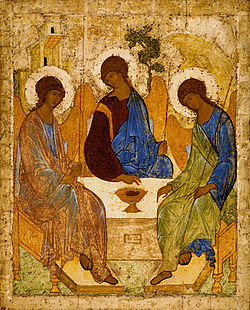Russian Orthodoxy


| Part of a series on the |
| Eastern Orthodox Church |
|---|
| Overview |
Slavic Orthodox churches[1] or Russian Orthodoxy (Russian: Русское православие)[citation needed] is the body of several churches within the larger communion of Eastern Orthodox Christianity, whose liturgy is or was traditionally conducted in Church Slavonic language. Most Churches of the Russian Orthodox tradition are part of the Eastern Orthodox Church.
Origin
Historically, the term "Greek Orthodox" has been used to describe all Eastern Orthodox churches, since the term "Greek" can refer to the heritage of the Byzantine Empire.[2][3][4] However, the Ecumenical Patriarchate of Constantinople, as a center of power, will gradually lose a significant part of its authority in the eyes of Orthodox believers after the union with Rome in 1439. In December 1448, the Russian Orthodox Church de facto declared its autocephaly by instaling Jonas, a Russian bishop, as Metropolitan of Kiev and All Russia (with permanent residence in Moscow) without the approval of Patriarch Gregory III of Constantinople to replace the pro-union Isidore of Kiev.[5][6] After the fall of Constantinople and the end of the Orthodox-Catholic union, internal problems regarding the status of the Russian Church will result in a division between Greek and Russian believers within Eastern Orthodoxy. Having lost its Christian basileus after the Turkish conquest, the Moscow rulers soon began to consider themselves real Tsars (this title was already used by Ivan III), and therefore, according to them, the center of the Eastern Orthodox Church should be located in Moscow, and thus the bishop of Moscow should become the head of Orthodoxy.[7] With some Eastern Orthodox believers calling Moscow the "Third Rome", or the "New Rome", the Russian Church gained influence in the orthodox world outside the Ottoman Empire.[8] After this event, a series of doctrinal and liturgical differences would emerge in the Slavic Orthodox world, being cut off from its Greek counterpart. In spite of the end of the schism in 1560, by the mid 17th century the religious practices of the Russian Orthodox Church were distinct from those of the Greek Orthodox Church. Eventually, Patriarch Nikon of Moscow would reform the church and bring most of its practices back into accommodation with the contemporary forms of Greek Orthodox worship. This change, however, was rejected by a large group of traditionalists, who would come to be known as Old Ritualists.[9]
Church bodies
Part of the Eastern Orthodox Communion
- Autocephalous churches:
- Russian Orthodox Church
- Autonomous Churches (recognized):
- Autonomous Churches (semi-recognized):
- Exarchates:
- Archdiocese of Russian Orthodox churches in Western Europe
- Patriarchal Exarchate in Western Europe
- Patriarchal Exarchate in South-East Asia
- Russian Orthodox Church in Finland
- Russian Orthodox Patriarchal Parishes in the USA (& Mexico)[10]
- Russian Orthodox Patriarchal Parishes in Canada
- Metropolitan District of the Russian Orthodox Church in Kazakhstan
- Metropolitan district of the Russian Orthodox Church in Central Asia
- Directly subordinated dioceses outside Russia
- Diocese of Argentina and South America
- Diocese of Baku and Azerbaijan
- Diocese of Berlin and Germany
- Diocese of Budapest and Hungary
- Diocese of Vilnius and Lithuania
- Diocese of Vienna and Austria
- Polish Orthodox Church
- Czech and Slovak Orthodox Church
- Orthodox Church in America (except Romanian, Bulgarian and Albanian ethnical dioceses)
- Russian Orthodox Church
- Churches under the jurisdiction of the Patriarchate of Constantinople (itself not part of Russian Orthodoxy):
- Autonomous Churches (recognized):
- Autonomous Churches (semi-recognized):
- Exarchates:
- Churches with undefined status:
Outside the Eastern Orthodox Communion
- Non-canonical church bodies, schism from the Russian Orthodox Church and its autonomous churches:
See also
Literature
- Русское православие: вехи истории / Науч. ред. А. И. Клибанов. — М.: Политиздат, 1989. — 719 с. — 200 000 экз. — ISBN 5-250-00246-3.
- Гордиенко Н. С. Содержание и объём понятия «русское православие» // Вестник Ленинградского государственного университета им. А. С. Пушкина. — 2009. — No. 2. — С. 166–175.
- Лексин В. Н. Русское православие сегодня // Контуры глобальных трансформаций: политика, экономика, право. — 2018. — No. 4. — doi:10.23932/2542-0240-2018-11-4-65-82.
References
- ^ Auburger, Leopold (1987↑page=363). "Classical Language/Ritual Language". In Ulrich Ammon, Norbert Dittmar, Klaus J. Mattheier and Peter Trudgill (ed.). Sociolinguistics / Soziolinguistik: An International Handbook of the Science of Language and Society / Ein internationales Handbuch zur Wissenschaft von Sprache und Gesellschaft. Vol. 1♀location=Berlin/NY. De Gruyter.
From the late 9th century on there is a special common Church Slavonic for the Slavic Orthodox Churches (shaped by Cyril and his brother Method [...]
{{cite book}}: Check date values in:|year=(help)CS1 maint: multiple names: editors list (link) CS1 maint: year (link) - ^ Boyd, Kelly (August 8, 1999). Encyclopedia of Historians and Historical Writing. Taylor & Francis. ISBN 9781884964336 – via Google Books.
- ^ Edwin Pears, The Destruction of the Greek Empire and the Story of the Capture of Constantinople by the Turks, Haskell House, 1968
- ^ Millar, Fergus (2006). A Greek Roman Empire : Power and Belief under Theodosius II (408–450). University of California Press. p. 279 pages. ISBN 0-520-24703-5.
- ^ "Primacy and Synodality from an Orthodox Perspective". Retrieved 5 March 2015.
- ^ "ИОНА". Archived from the original on 29 March 2015. Retrieved 5 March 2015.
- ^ Strémooukhoff, Dimitri (1953). "Moscow the Third Rome: Sources of the Doctrine". Speculum. 28 (1): 84–101. doi:10.2307/2847182. JSTOR 2847182. S2CID 161446879.
- ^ Parry, Ken; Melling, David, eds. (1999). The Blackwell Dictionary of Eastern Christianity. Malden, MA: Blackwell Publishing. p. 490. ISBN 978-0-631-23203-2.
- ^ "Raskol".
- ^ Parish Directory of the Russian Orthodox Church in the USA
